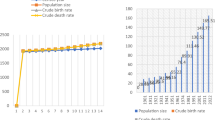Abstract
Since 1949, great changes have take place in the amount and distribution of China’s urban population. From the analysis on the change in total urban population, it can be learnt that urbanization progress can be controlled mainly by social-economic development and government policy through influencing the migratory growth of urban population and the number of organic cities. In the period 1949–1990, the states of megalopolises had gone up; medium-sized cities had decreased. It is estimated that the total urban population of China will still increase at a rapid speed in the coming 10 years; there will not be great changes in grade system of urban scale; and urban population may shows a tendency to move to coastal area.
Similar content being viewed by others
References
中国社会科学院人口研究中心, 中国人口年鉴. 北京: 中国社会科 学出版社, 1985. 811–846.
中国社会科学院人口研究中心, 中国人口年鉴. 北京: 中国社会科 学出版社, 1986. 409–431.
中华人民共和国公安部. 全国分县市人口统计资料. 北京: 中国地图出版社, 1989, 13–54.
Author information
Authors and Affiliations
Rights and permissions
About this article
Cite this article
Li, R. Onspatial and temporal changes of present urban population in China. Chinese Geographical Science 3, 326–333 (1993). https://doi.org/10.1007/BF02664285
Issue Date:
DOI: https://doi.org/10.1007/BF02664285




